“Not everything that matters can be measured,
and not everything that is measured matters.”
Elliot Eisner
We live in the age of “Big Data.” Information floods our lives on an ongoing basis. And in the training world, that means wearables and trackers which permit us to collect our own “big data.” Side note: The largest fitness show is now the CES (consumer electronics show) where an entire floor is dedicated to fitness wearables and according to Forbes 125.5 million devices were estimated to be shipped in 2017. Big deal, this big data.
Now I will come out and say that I am a bit data-averse. And over the years, beyond a heart rate monitor, I have not successfully integrated “big data” into my training. But I may have found something that is changing my mind.
What am I tracking that is changing my mind?
Power and Velocity.
Velocity based training has become a trend in strength and conditioning. And the blog at Train With Push is an excellent resource.
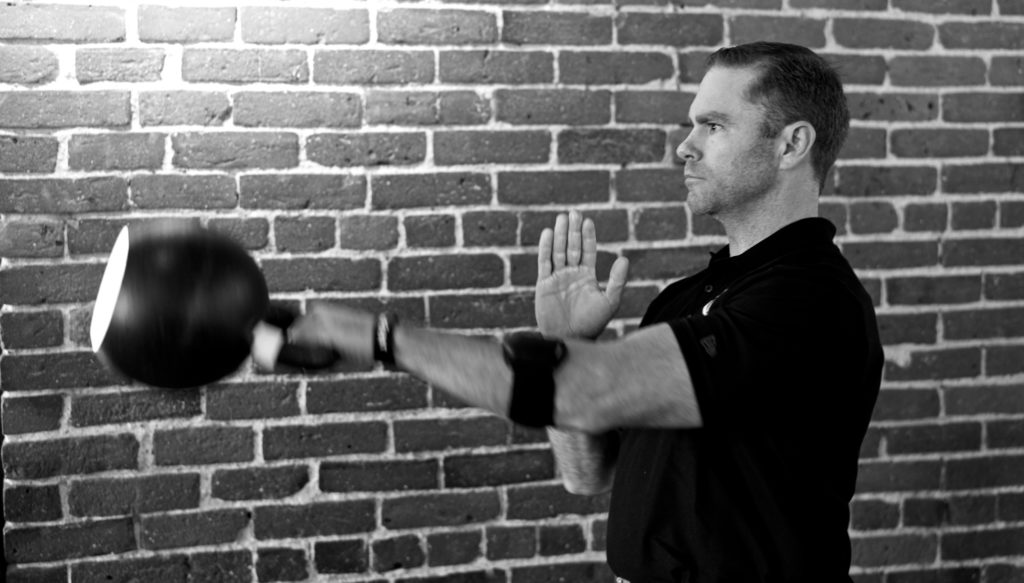
A quick detour
In physics there is something known as the Observer Effect, basically meaning that the act of observing something changes it. As noted in this article on Science Daily, research shows that:
“When a quantum “observer” is watching quantum mechanics states that [sic] particles can also behave as waves. This can be true for electrons at the submicron level, i.e., at distances measuring less than one micron, or one one-thousandth of a millimeter. When behaving as waves, they can simultaneously pass through several openings in a barrier and then meet again at the other side of the barrier. This “meeting” is known as interference.
Strange as it may sound, interference can only occur when no one is watching. Once an observer begins to watch the particles going through the openings, the picture changes dramatically: If a particle can be seen going through one opening, then it’s clear it didn’t go through another. In other words, when under observation, electrons are being “forced” to behave like particles and not like waves. Thus, the mere act of observation affects the experimental findings.”
(How cool is that?)
Essentially, the act of observing something can influence the thing being observed, and when I started “observing” my swings with the PUSH band it absolutely influenced what I was doing.
I began to max out (swing at a volume setting of 11—Spinal Tap reference) my swings and it had a big impact on my form. Due to the amount of power produced, I was not holding my finish position but was unhinging and sitting back slightly to counterbalance the kettlebell (I was even pulled off the ground on a couple of reps). This was subconscious. I immediately had the volume knob way up to max out my power, since it was being measured—and I did not realize the impact it had on my form until looking at video. And it also highlighted a difference in power between my right and left arm swings. (Left being more powerful, even though it is my non-dominant arm.)
Just be aware that the Observer Effect applies to swings, as well.
Moving on
Why measure power and velocity?
It assists us in knowing when to stop a set.
Why is it important to know when to stop a set?
Understanding the cost of training and how to maximize the return on investment of training.
In Strong Endurance™ Pavel has emphasized understanding the cost levied by the different energy systems. The goal is to prioritize high power output with adequate rest periods so that your body builds capacity in energy production and becomes more efficient in dealing with the byproducts of that energy production. Craig Marker has a couple of articles that dive a bit deeper into these concepts and Pavel has some great information in this article: Simple and Sinister Progression Tactic.
So, the question for me has become: “What is the cost?”
If I am programming for myself or my students, I ask myself that question. Understanding the cost associated with something is critical to programming and recovery. And the best recovery strategy is proper programming!
What does this have to do with velocity and power measurement/tracking?
In Dan Baker’s excellent article series available on the trainwithpush.com website, he details research done using velocity loss as the metric for training.
“…the researchers (Gonzales-Badillo et al. 2016) looked at the relationship between velocity, effort, and fatigue, and the consequent training adaptations and time course of recovery from fatiguing and less-fatiguing workouts. The study investigated the effects of performing 3 x 4 @ 80% 1RM (with about a 20% velocity decline) versus 3 x 8 @ 80% 1RM (with about a 40% velocity decline) for squats. The results were that jumping capabilities of the athletes performing the 3 x 4 workout were recovered within 6 to 24 hours. The results for the 3 x 8 group were not fully recovered at the 48-hour mark.”
This research syncs well with Plan Strong™ methodology and enhanced recovery. What is interesting is the drop in velocity which Pallares, et al. put into action in their 2016 research.
See below:
“…the researchers (Pallares et al. 2016) trained two groups of athletes for 8-weeks using a periodized training approach ranging from 70 to 85% 1RM. What distinguished between the groups was that one groups ceased their squats sets at a 40% velocity decline within the set and the other group trained to a 20% velocity decline within the set, irrespective of what % 1RM or how many reps were performed.
Across the 8-wks, the 20% decline group performed only 60% of the workload/reps of the 40% decline group. The results were the same for increases in 1RM squat strength, but the 20% decline group had better jumping improvements while the 40% decline group had better muscle size gains. However, these greater gains in muscle size also came with a catch ~ there was a decrease in the percentage of explosive MHC 2 fibers! This is not an outcome that power athletes would desire, as these are the more explosive muscle fibers.”
The big takeaway
Higher reps and large decreases in velocity within a set result in large increases in lactate and ammonia, which make it more difficult to recover from the resistance training session.
Please note the 6 to 24-hour recovery vs. 48+ hour recovery in the one study and the benefits achieved at only 60% of the workload in the other (without sacrificing explosive fibers!).
This is strong endurance!
Now you may be thinking that you “know” when power drops off, etc., but I can assure you that based on my experience with the PUSH band and my years and many reps of swings—you are not.
What does it look like?
Sample training sessions
Feb. 14, 2018: one-arm swings with 40kg
10 every 2 min x 6
Set 1: L x 10 – peak power 1846
Set 2: R x 10 – peak power 1836
Set 3: L x 10 – peak power 1841
Set 4: R x 10 – peak power 1846
Set 5: L x 10 – peak power 1821
Set 6: R x 10 – peak power 1872
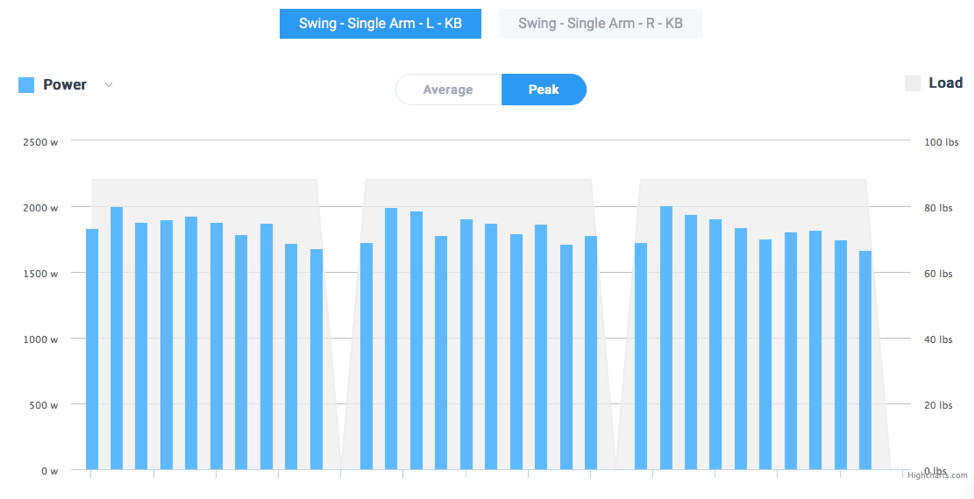
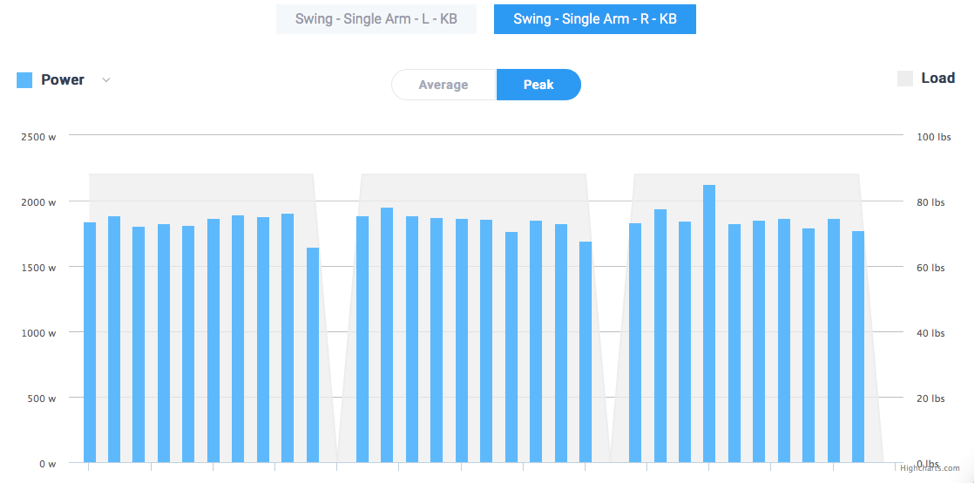
This was a short practice session with ample rest where loss of velocity was not likely, but had it happened or if I was coming into my training without full recovery, etc., I would have been able to see it and quantify it right away. Sets were performed at about a volume setting (effort) of 6-7 and you can see good power.
So what does a session look like where I push to the point of losing power?
March 1, 2018
Two-arm swing 40 kg x 10 x 10 sets
30 seconds rest between sets
Set 1: peak power 2204
Set 2: peak power 2159
Set 3: peak power 2104
Set 4: peak power 1928
Set 5: peak power 2188
Set 6: peak power 1946
Set 7: peak power 1877
Set 8: peak power 1905
Set 9: peak power 1782
Set 10: peak power 1770
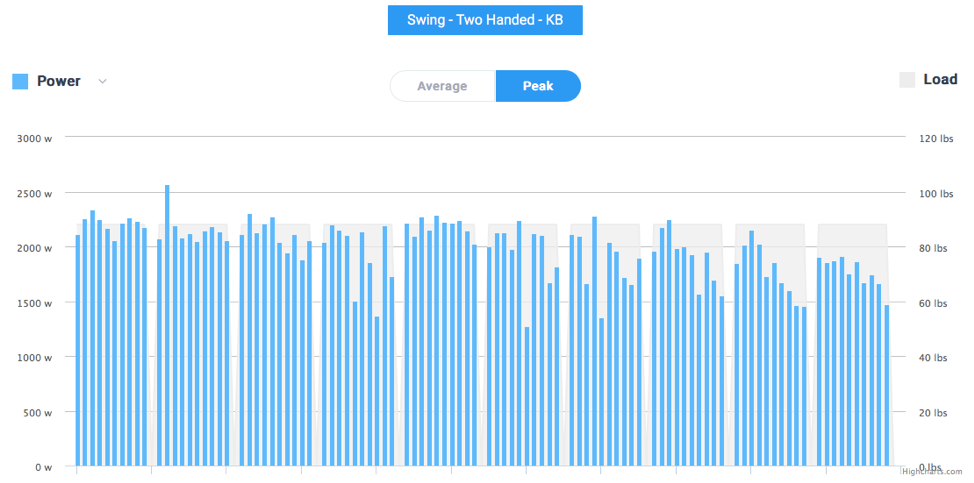
Please note the drop off in power and velocity in the last two sets. I felt “beat up” by the session—which validates the idea of stopping at 10%-20% or so of drop off and of not recovering well if you do not stop the session at that point. I should have stopped after set 8 and possibly after set 7.
Limitations
You do need to wear the band on the arm performing the exercise. This means switching arms each set on most protocols. With enough of a rest period this isn’t difficult, but with short rest it can be an issue or you would track only one arm, etc. But having used the PUSH band for some time now, I find the protocols easy to input and the device easy to use (even switching hands in a 20-second rest period).
Conclusion
Changing my mind on big data might not be there fully, but I think I can embrace this technology and benefit from tracking velocity and power. Identifying left-to-right asymmetries in power or velocity and managing drop offs in power and velocity can be huge to understanding the cost of training. And the benefits of managing that cost is what put StrongFirst and Strong Endurance™ at the forefront of strength and conditioning information. This is why StrongFirst and PUSH have partnered in order to bring these valuable metrics to our students. (Now available!)
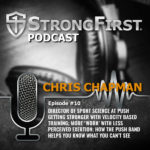


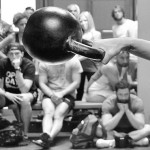




Hi Brett! I just got my Push a few days ago, and have been testing it out. I have focused on the Power output data as you have in your article, but am curious as to how the velocity data relates to training protocols with swings or other ballistic movements, or if I should just focus on the Power data.
My guess is the velocity data reports how fast a rep is completed and that I would want consistent velocity over the course of the set if I am using consistent power and getting a good float on the bell.
Can you provide any insight on this?
P.S. I will leave the full physics argument for another day, but I will say that while I agree that there is clearly some type of observer effect taking place with the Push, it is not exactly the same as the Quantum Observer Effect regarding the wave v. particle nature of electrons. In particular because I think that one of the goals (and the value) of the PUSH is to eliminate the “observer effect” — get the data (observer) and the behavior (swing form and perception of power) to match. To my knowledge this is not possible with electrons. When you observe them , the will always behave like particles, and never like waves.
Eileen
I fully understand that the observer effect of the PUSH band is not the same as the electrons – it was just a way to introduce the concept in an interesting way.
I think the key is to be aware of the observer effect not to “eliminate it”.
Velocity is part of power so measuring one is a proxy for the other but I will see if I can get one of the PUSH reps to provide a more complete answer.
Thanks Brett. What I saw in my data is that the velocity and the power do not always correlate. So that is why I was curious about velocity.
Although I see and plan to take full advantage of applying the data to programming, I think I am most interested in whether I can train my perception of my power to match the data being recorded. So that after time, I will have the same output whether I am using the Push or not because I can better sense and control my power production. That is what I was trying to get to with the notion of eliminating the observer effect. Not sure is that makes sense. In any event, I think this will be a great tool for collecting and applying data feedback. And I find it very easy to use during training.
You’re misusing the word “Observer Effect”. That effect is specifically a quantum phenomenon where the mere fact of seeing something (which requires throwing a photon of light to a particle) actually changes particle behavior (because the photon literally affects the electron you’re looking at). It’s a rewording of the Heisenberg uncertainty principle.
What you describe is what’s called “bias”. You behave differently because you expect to do so due to the band. To have a controlled experiment you’d need to somehow record swing power without being told it’s occuring. Which obviously cannot be done with the band because you know when you have it on.
Bias is reduced in science via double-blind procedures (and it can be eliminated in this particular Swing case study with enough resources). The observer Effect, on the other hand, cannot be eliminated as it is a fundamental law of quantum physics that electrons and light have wave and particle behavior.
Hope that makes sense.
I click submit before realizing sorry !
Anyways, very good article and great data. I am a fan of science and really enjoy scientific material in strength worlds.
IcyROM
Respectfully disagree
Bias (a strong inclination or preconceived opinion) was not what was going on.
I added the device (measured my swing) and I changed my swing – observer effect.
Observer effect occurs in many areas
https://en.wikipedia.org/wiki/Observer_effect
(sociological for example – Hawthrone effect) beyond physics and yes there is “bias” in the observer effect.
IcyROM
Respectfully disagree
Bias (a strong inclination or preconceived opinion) was not what was going on.
I added the device (measured my swing) and I changed my swing – observer effect.
Observer effect occurs in many areas
(sociological for example – Hawthrone effect – see below) beyond physics and yes there is “bias” in the observer effect.
It sounds very interesting. I am not data adverse (quite the opposite) and I am going to try it.
These look great and I found those studies very interesting. Considering I do mainly bodyweight training would this be helpful for me? I’m not sure this would work for things like dips, pullups, pushups on rings due to the arms not really moving. Is there a chest mount or anything like that? Or is this primarily for kettlebell and barbell movements?
Interesting info regardless!
Daniel
yes
the band has a chest strap and is used for bodyweight training as well.
Thanks for the article, Brett.
Can you give some details on how you’ve changed your training with the requirement to switch arms using the PUSH band.
I’m also curious how it is worn for 2-handed swings, cleans, and snatches.
Is there any provision to attach it directly to the KB with a magnet?
Mustafa Kujo
For single arm work the band is worn on the arm moving the KB.
For two-arm swings the band can stay on one arm.
I believe they are working on a version to be attached to the KB but will check. (they already have it set to be attachable to a barbell)
I wouldn’t say my training has changed but I have learned more from my training.
Some sets where I felt my power had dropped it hadn’t and some where I felt great it had – so it helps me “know”.
Great article. I will check out the other links too. Seems like if you can capture the data and also internalize how your body feels, heart rate, etc… you can learn the signals and sensations your body gives letting you know where you are at on this continuum. More body awareness coupled with the data seems to be a powerful resource. I think the more body awareness you have, the safer and stronger you can be.
Interesting concept, and I love how strength and conditioning is getting more and more nuanced. It’s so fascinating how exact and concise training is becoming.
Side note: Pretty jealous of all those who get to attend Strong Endurance and Plan Strong. Please remember to post in the forum your experience (even if you can’t give too much away)!!
Brett,
You don’t have to rely on forced 😉 links to physics. The observer affecting the outcome is well-known in the social sciences. See . This history of how this was realized is also very interesting and makes for a good story to summarize when discussing the effect.
Manuel
I am well aware of the social sciences aspect of the observer effect – the Physics aspect of the observer effect is a bit more applicable to the power, velocity etc… aspects of the article IMO
And how cool is it that electrons appear as particles or waves depending on being observed.
https://en.wikipedia.org/wiki/Observer_effect_(physics)
https://en.wikipedia.org/wiki/Observer_effect
And there are other aspects of the observer effect from other areas…
Chief,
This is fantastic! I am even more excited to attend StrongEndurance seminar next weekend.
I can’t wait to use this type of technology with endurance athletes such as rowers and runners.
Thank you.
Excellent – looking forward to your feedback